Zihan Huang
Reinforcement Learning for Active Matter
Mar 30, 2025Abstract:Active matter refers to systems composed of self-propelled entities that consume energy to produce motion, exhibiting complex non-equilibrium dynamics that challenge traditional models. With the rapid advancements in machine learning, reinforcement learning (RL) has emerged as a promising framework for addressing the complexities of active matter. This review systematically introduces the integration of RL for guiding and controlling active matter systems, focusing on two key aspects: optimal motion strategies for individual active particles and the regulation of collective dynamics in active swarms. We discuss the use of RL to optimize the navigation, foraging, and locomotion strategies for individual active particles. In addition, the application of RL in regulating collective behaviors is also examined, emphasizing its role in facilitating the self-organization and goal-directed control of active swarms. This investigation offers valuable insights into how RL can advance the understanding, manipulation, and control of active matter, paving the way for future developments in fields such as biological systems, robotics, and medical science.
Towards High-performance Spiking Transformers from ANN to SNN Conversion
Feb 28, 2025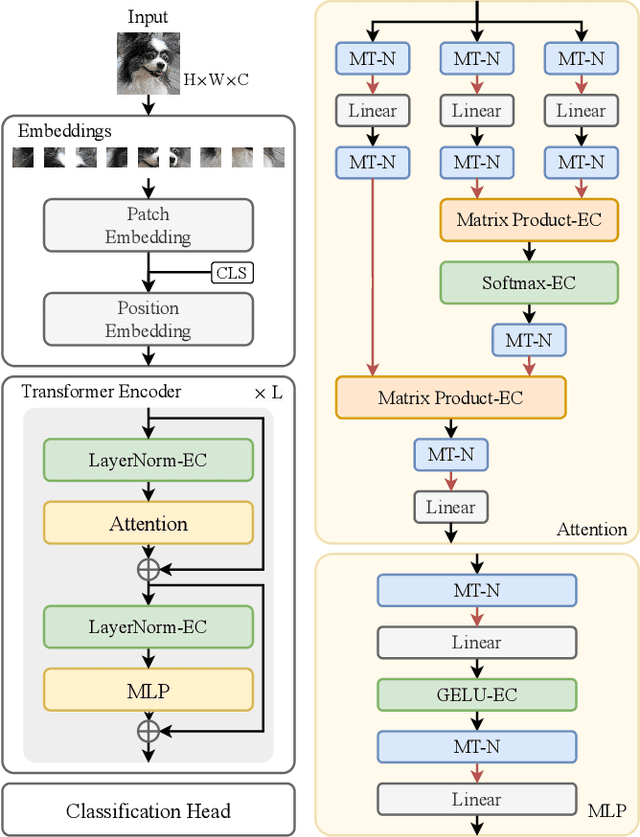
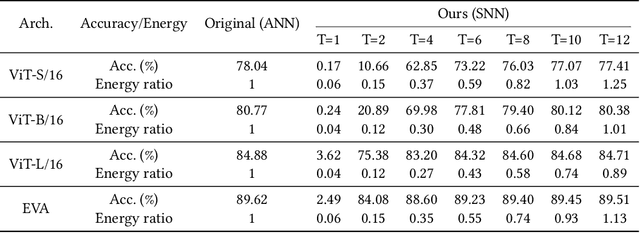
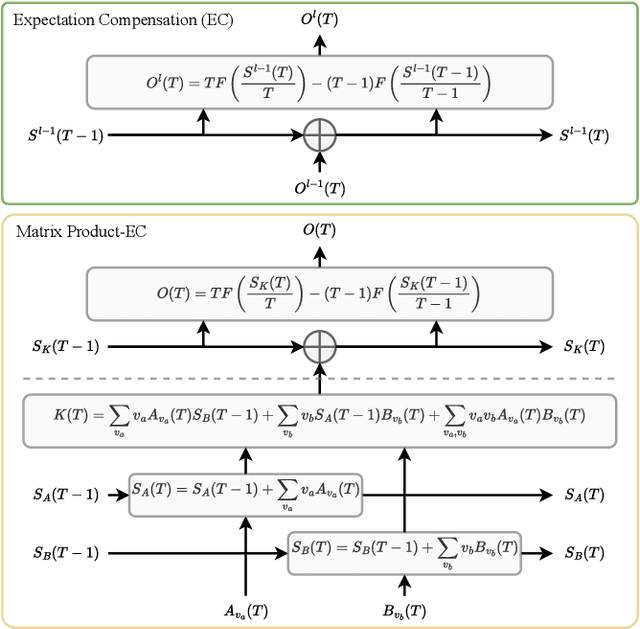
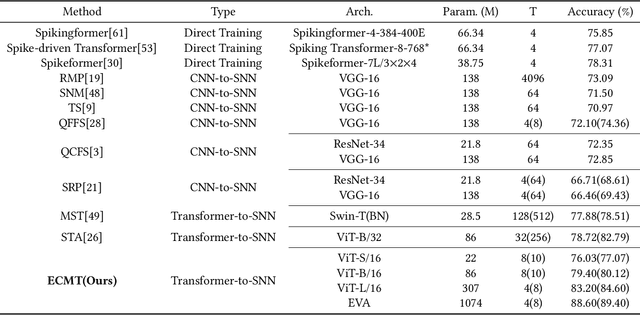
Abstract:Spiking neural networks (SNNs) show great potential due to their energy efficiency, fast processing capabilities, and robustness. There are two main approaches to constructing SNNs. Direct training methods require much memory, while conversion methods offer a simpler and more efficient option. However, current conversion methods mainly focus on converting convolutional neural networks (CNNs) to SNNs. Converting Transformers to SNN is challenging because of the presence of non-linear modules. In this paper, we propose an Expectation Compensation Module to preserve the accuracy of the conversion. The core idea is to use information from the previous T time-steps to calculate the expected output at time-step T. We also propose a Multi-Threshold Neuron and the corresponding Parallel Parameter normalization to address the challenge of large time steps needed for high accuracy, aiming to reduce network latency and power consumption. Our experimental results demonstrate that our approach achieves state-of-the-art performance. For example, we achieve a top-1 accuracy of 88.60\% with only a 1\% loss in accuracy using 4 time steps while consuming only 35\% of the original power of the Transformer. To our knowledge, this is the first successful Artificial Neural Network (ANN) to SNN conversion for Spiking Transformers that achieves high accuracy, low latency, and low power consumption on complex datasets. The source codes of the proposed method are available at https://github.com/h-z-h-cell/Transformer-to-SNN-ECMT.
Channel-wise Parallelizable Spiking Neuron with Multiplication-free Dynamics and Large Temporal Receptive Fields
Jan 24, 2025Abstract:Spiking Neural Networks (SNNs) are distinguished from Artificial Neural Networks (ANNs) for their sophisticated neuronal dynamics and sparse binary activations (spikes) inspired by the biological neural system. Traditional neuron models use iterative step-by-step dynamics, resulting in serial computation and slow training speed of SNNs. Recently, parallelizable spiking neuron models have been proposed to fully utilize the massive parallel computing ability of graphics processing units to accelerate the training of SNNs. However, existing parallelizable spiking neuron models involve dense floating operations and can only achieve high long-term dependencies learning ability with a large order at the cost of huge computational and memory costs. To solve the dilemma of performance and costs, we propose the mul-free channel-wise Parallel Spiking Neuron, which is hardware-friendly and suitable for SNNs' resource-restricted application scenarios. The proposed neuron imports the channel-wise convolution to enhance the learning ability, induces the sawtooth dilations to reduce the neuron order, and employs the bit shift operation to avoid multiplications. The algorithm for design and implementation of acceleration methods is discussed meticulously. Our methods are validated in neuromorphic Spiking Heidelberg Digits voices, sequential CIFAR images, and neuromorphic DVS-Lip vision datasets, achieving the best accuracy among SNNs. Training speed results demonstrate the effectiveness of our acceleration methods, providing a practical reference for future research.
Machine Learning Analysis of Anomalous Diffusion
Dec 02, 2024



Abstract:The rapid advancements in machine learning have made its application to anomalous diffusion analysis both essential and inevitable. This review systematically introduces the integration of machine learning techniques for enhanced analysis of anomalous diffusion, focusing on two pivotal aspects: single trajectory characterization via machine learning and representation learning of anomalous diffusion. We extensively compare various machine learning methods, including both classical machine learning and deep learning, used for the inference of diffusion parameters and trajectory segmentation. Additionally, platforms such as the Anomalous Diffusion Challenge that serve as benchmarks for evaluating these methods are highlighted. On the other hand, we outline three primary strategies for representing anomalous diffusion: the combination of predefined features, the feature vector from the penultimate layer of neural network, and the latent representation from the autoencoder, analyzing their applicability across various scenarios. This investigation paves the way for future research, offering valuable perspectives that can further enrich the study of anomalous diffusion and advance the application of artificial intelligence in statistical physics and biophysics.
A Survey on Human-Centric LLMs
Nov 26, 2024



Abstract:The rapid evolution of large language models (LLMs) and their capacity to simulate human cognition and behavior has given rise to LLM-based frameworks and tools that are evaluated and applied based on their ability to perform tasks traditionally performed by humans, namely those involving cognition, decision-making, and social interaction. This survey provides a comprehensive examination of such human-centric LLM capabilities, focusing on their performance in both individual tasks (where an LLM acts as a stand-in for a single human) and collective tasks (where multiple LLMs coordinate to mimic group dynamics). We first evaluate LLM competencies across key areas including reasoning, perception, and social cognition, comparing their abilities to human-like skills. Then, we explore real-world applications of LLMs in human-centric domains such as behavioral science, political science, and sociology, assessing their effectiveness in replicating human behaviors and interactions. Finally, we identify challenges and future research directions, such as improving LLM adaptability, emotional intelligence, and cultural sensitivity, while addressing inherent biases and enhancing frameworks for human-AI collaboration. This survey aims to provide a foundational understanding of LLMs from a human-centric perspective, offering insights into their current capabilities and potential for future development.
Improving the Language Understanding Capabilities of Large Language Models Using Reinforcement Learning
Oct 14, 2024Abstract:Large language models (LLMs), built on decoder-only transformers, excel in natural language generation and adapt to diverse tasks using zero-shot and few-shot prompting. However, these prompting methods often struggle on natural language understanding (NLU) tasks, where encoder-only models like BERT-base outperform LLMs on benchmarks like GLUE and SuperGLUE. This paper explores two approaches-supervised fine-tuning (SFT) and proximal policy optimization (PPO)-to enhance LLMs' NLU abilities. To reduce the cost of full-model fine-tuning, we integrate low-rank adaptation (LoRA) layers, limiting updates to these layers during both SFT and PPO. In SFT, task-specific prompts are concatenated with input queries and ground-truth labels, optimizing with next-token prediction. Despite this, LLMs still underperform compared to models like BERT-base on several NLU tasks. To close this gap, we apply PPO, a reinforcement learning technique that treats each token generation as an action and uses a reward function based on alignment with ground-truth answers. PPO then updates the model to maximize these rewards, aligning outputs with correct labels. Our experiments with LLAMA2-7B show that PPO improves performance, with a 6.3-point gain over SFT on GLUE. PPO exceeds zero-shot by 38.7 points and few-shot by 26.1 points on GLUE, while surpassing these by 28.8 and 28.5 points on SuperGLUE. Additionally, PPO outperforms BERT-large by 2.7 points on GLUE and 9.3 points on SuperGLUE. The improvements are consistent across models like Qwen2.5-7B and MPT-7B, highlighting PPO's robustness in enhancing LLMs' NLU capabilities.
Unsupervised Low Light Image Enhancement Using SNR-Aware Swin Transformer
Jun 03, 2023



Abstract:Image captured under low-light conditions presents unpleasing artifacts, which debilitate the performance of feature extraction for many upstream visual tasks. Low-light image enhancement aims at improving brightness and contrast, and further reducing noise that corrupts the visual quality. Recently, many image restoration methods based on Swin Transformer have been proposed and achieve impressive performance. However, On one hand, trivially employing Swin Transformer for low-light image enhancement would expose some artifacts, including over-exposure, brightness imbalance and noise corruption, etc. On the other hand, it is impractical to capture image pairs of low-light images and corresponding ground-truth, i.e. well-exposed image in same visual scene. In this paper, we propose a dual-branch network based on Swin Transformer, guided by a signal-to-noise ratio prior map which provides the spatial-varying information for low-light image enhancement. Moreover, we leverage unsupervised learning to construct the optimization objective based on Retinex model, to guide the training of proposed network. Experimental results demonstrate that the proposed model is competitive with the baseline models.
Time-aware Self-Attention Meets Logic Reasoning in Recommender Systems
Aug 29, 2022



Abstract:At the age of big data, recommender systems have shown remarkable success as a key means of information filtering in our daily life. Recent years have witnessed the technical development of recommender systems, from perception learning to cognition reasoning which intuitively build the task of recommendation as the procedure of logical reasoning and have achieve significant improvement. However, the logical statement in reasoning implicitly admits irrelevance of ordering, even does not consider time information which plays an important role in many recommendation tasks. Furthermore, recommendation model incorporated with temporal context would tend to be self-attentive, i.e., automatically focus more (less) on the relevance (irrelevance), respectively. To address these issues, in this paper, we propose a Time-aware Self-Attention with Neural Collaborative Reasoning (TiSANCR) based recommendation model, which integrates temporal patterns and self-attention mechanism into reasoning-based recommendation. Specially, temporal patterns represented by relative time, provide context and auxiliary information to characterize the user's preference in recommendation, while self-attention is leveraged to distill informative patterns and suppress irrelevances. Therefore, the fusion of self-attentive temporal information provides deeper representation of user's preference. Extensive experiments on benchmark datasets demonstrate that the proposed TiSANCR achieves significant improvement and consistently outperforms the state-of-the-art recommendation methods.
Context-Aware Legal Citation Recommendation using Deep Learning
Jun 20, 2021
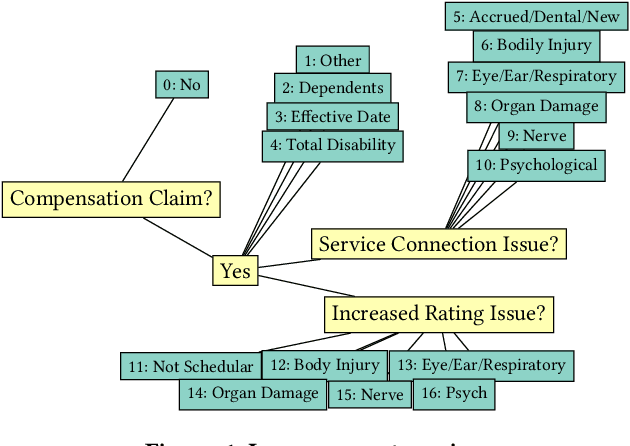
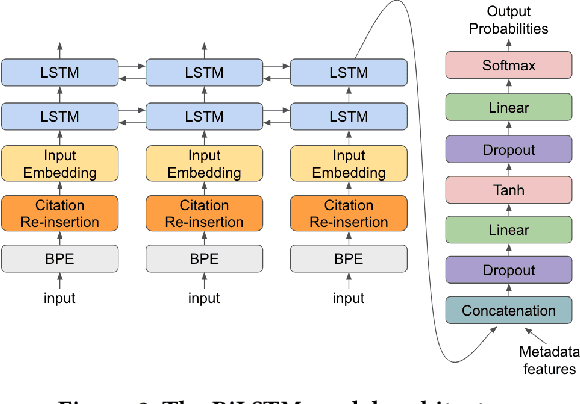

Abstract:Lawyers and judges spend a large amount of time researching the proper legal authority to cite while drafting decisions. In this paper, we develop a citation recommendation tool that can help improve efficiency in the process of opinion drafting. We train four types of machine learning models, including a citation-list based method (collaborative filtering) and three context-based methods (text similarity, BiLSTM and RoBERTa classifiers). Our experiments show that leveraging local textual context improves recommendation, and that deep neural models achieve decent performance. We show that non-deep text-based methods benefit from access to structured case metadata, but deep models only benefit from such access when predicting from context of insufficient length. We also find that, even after extensive training, RoBERTa does not outperform a recurrent neural model, despite its benefits of pretraining. Our behavior analysis of the RoBERTa model further shows that predictive performance is stable across time and citation classes.
WaveNet-Based Deep Neural Networks for the Characterization of Anomalous Diffusion
Jun 14, 2021



Abstract:Anomalous diffusion, which shows a deviation of transport dynamics from the framework of standard Brownian motion, is involved in the evolution of various physical, chemical, biological, and economic systems. The study of such random processes is of fundamental importance in unveiling the physical properties of random walkers and complex systems. However, classical methods to characterize anomalous diffusion are often disqualified for individual short trajectories, leading to the launch of the Anomalous Diffusion (AnDi) Challenge. This challenge aims at objectively assessing and comparing new approaches for single trajectory characterization, with respect to three different aspects: the inference of the anomalous diffusion exponent; the classification of the diffusion model; and the segmentation of trajectories. In this article, to address the inference and classification tasks in the challenge, we develop a WaveNet-based deep neural network (WADNet) by combining a modified WaveNet encoder with long short-term memory networks, without any prior knowledge of anomalous diffusion. As the performance of our model has surpassed the current 1st places in the challenge leaderboard on both two tasks for all dimensions (6 subtasks), WADNet could be the part of state-of-the-art techniques to decode the AnDi database. Our method presents a benchmark for future research, and could accelerate the development of a versatile tool for the characterization of anomalous diffusion.
 Add to Chrome
Add to Chrome Add to Firefox
Add to Firefox Add to Edge
Add to Edge